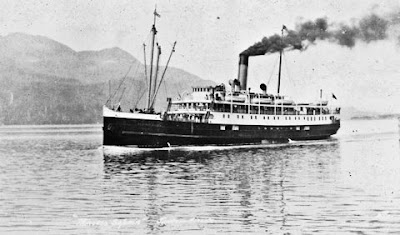Few
people have heard about the sinking of the Princess Sophia, but it was a
major tragedy that deserves a place in this series. Today’s post is a reprint
from June 18, 2012. I have made a few minor changes for formatting and similar purposes.
No
Survivors
At 2:10 a.m. on
October 24, 1918, the Princess Sophia
ran aground on Vanderbilt Reef in Lynn Canal, which is part of Alaska’s Inner
Passage. The ship stayed there, firmly wedged in the rocks, for almost 40 hours
before the wind and the waves changed course and sent the severely damaged ship
to its death. During that time, the 278 passengers and 65 crew members watched
other boats circling the wreck and waited to be rescued. And yet, there were no
survivors.1
The picture shows the Princess Sophia around 1912, shortly after she was built.2
She was 245 feet long and could carry up to 500 passengers with special
permission, although her normal capacity was 250.
The Princess
Sophia made regular runs between Vancouver, Canada and Skagway, Alaska from
late spring through early fall. In October, many residents of Alaska and the
Yukon went “outside” for the winter, much as the Florida snowbirds head south
today. In 1918, many felt lucky to have tickets on the Princess Sophia for one of the last trips out by water.
The passengers on that fateful trip ranged
from gold miners and laborers to politicians and businessmen and their
families. The passenger manifest included 37 women and 18 children.
Not long after the Princess Sophia left Skagway, it ran into a blinding snowstorm.
Captain Locke had experienced white-out conditions before, and he did not slow
down. So when he got off course and ran into Vanderbilt Reef, the ship went
right up onto the rocks and stuck fast.
The Princess
Sophia put out a distress call and was soon surrounded by would-be
rescuers. But the reef and the gale conditions made it impossible for those
boats to get close. Captain Locke considered putting his passengers into
lifeboats but was concerned that they would capsize in the raging waves and the
occupants would drown—something that had recently happened in another
shipwreck. Since the Princess Sophia
was firmly wedged in the rocks of the shallow reef, he decided to stay put
until the weather calmed down. Several high tides passed without budging the
ship, which seemed to confirm his judgment.
But late in the afternoon of October 25, the
wind shifted and pushed the ship off the rocks. With the huge gashes cut into
the hull by the original grounding, the Princess
Sophia never had a chance. And because of the stormy conditions and the
darkness, the would-be rescuers could only pray for the passengers’ safety. A
prayer that God answered in his own way, but not as the rescuers hoped.
The official inquiry concluded that the
accident was nobody’s fault and the decision to wait before evacuating the
passengers was a judgment call that could have gone either way. But the
politicians in Washington may share part of the blame. For years, Alaskan
shipping interests had been asking for a light on Vanderbilt Reef, and their
pleas had gone unanswered. After the Princess
Sophia sank, they finally got their light.
Why do so few people remember the Princess Sophia today? I think it is
because there are no survivor stories to add to the romance.
But I would love to know what the passengers
thought and did as they were trapped on the stranded ship.










No comments:
Post a Comment